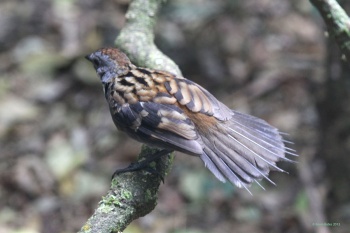Alternative names: Southern Logrunner; Brown Logrunner; Spine-tailed Logrunner; Spine-tailed Chowchilla, Scrubquail; Scrubhen
- Orthonyx temminckii
Identification
18 - 21cm. The upperside is cryptically patterned with brown, grey, and black, head is grey on the side, and the chin, throat and breast are in the male pure white, reddish-orange in the female. The remiges are very short, rounded and much incurved, showing a bird of weak flight. The rectrices are very broad, the shafts stiff, and towards the tip without barbs. Juveniles have rufous upperparts and feathers with pale central streaks and blackish-brown tips.
Distribution
Eastern Australia: very locally distributed from New South Wales to Queensland. (Bunya Mountains to central NSW)
Most common in northern parts of range.
Taxonomy
Papuan Logrunner or Northern Logrunner, Orthonyx novaeguineae, found locally in New Guinea, was formerly considered a subspecies of this species. One of the things that (again) caused these species to be split was a DNA analysis1.
This is a monotypic species[2].
Habitat
Subtropical montane rainforest floor.
Behaviour
It is strictly terrestrial in its habits. They will often be half buried in the leaf litter and as such difficult to see as only the upper surface shows above the leaves.
Diet
Insects and larvae are their chief food, found by scraping and throwing leaves around.
Breeding
The males are described as performing dancing antics like those of the lyrebird. It builds a domed nest on or near the ground. Lays usually 2 eggs.
References
- J. A. Norman, L. Christidis, L. Joseph, B. Slikas & D. Alpers (2002) Unravelling a biogeographical knot: origin of the 'leapfrog' distribution pattern of Australo-Papuan sooty owls (Strigiformes) and logrunners (Passeriformes). Proceedings of the Royal Society of London Series B. Biological Sciences. 269, 2127-2133. (Full text available online).
- Clements, J. F., T. S. Schulenberg, M. J. Iliff, B.L. Sullivan, C. L. Wood, and D. Roberson. 2013. The eBird/Clements checklist of birds of the world: Version 6.8., with updates to August 2013. Downloaded from http://www.birds.cornell.edu/clementschecklist/download/
- Del Hoyo, J, A Elliott, and D Christie, eds. 2007. Handbook of the Birds of the World. Volume 12: Picathartes to Tits and Chickadees. Barcelona: Lynx Edicions. ISBN 978-8496553422
Recommended Citation
- BirdForum Opus contributors. (2025) Australian Logrunner. In: BirdForum, the forum for wild birds and birding. Retrieved 26 April 2025 from https://www.birdforum.net/opus/Australian_Logrunner
External Links
Search the Gallery using the scientific name:
Search the Gallery using the common name:
GSearch checked for 2020 platform.






